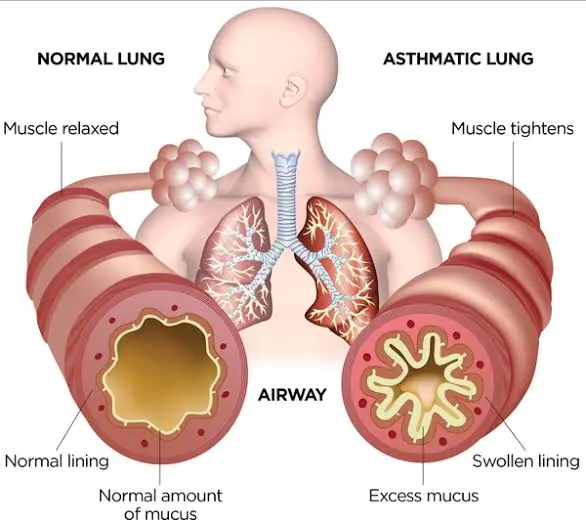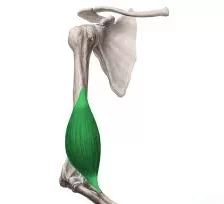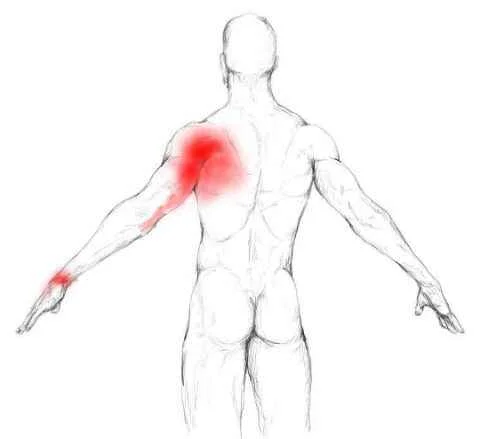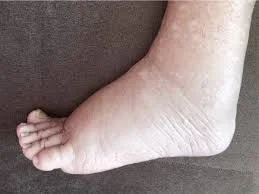Managing Asthma at Home: Effective Strategies for Symptom Relief and Prevention
Table of Contents
Introduction of Asthma
A lung condition known as asthma, or bronchial asthma, is what causes breathing difficulties. Being a chronic (ongoing) condition, it requires constant medical attention and doesn’t go away.
Currently, about 25 million Americans suffer from asthma. Over 5 million youngsters are included in this total. If therapy for your asthma is not received, it may become fatal.
An asthma attack: what is it?
Normal breathing allows air to pass through your airways softly and readily because the muscles surrounding them are relaxed. Three things may transpire during an asthma attack:
The muscles around the airways constrict (tighten) during a bronchospasm. Your breathing becomes more difficult as it constricts. Airways that are narrowed cannot allow air to pass freely.
The lining of your airways swells when you have inflammation. Less air can enter or exit swollen airways.
Production of mucous: Your body produces more mucus during the attack. The thick mucus obstructs the airways.
The sound your airways make when you exhale is known as wheezing, and it occurs as your airways get more constricted. Another term for an asthma episode could be a flare-up or an exacerbation. It’s the phrase used to describe uncontrolled asthma.
Causes of asthma
An increased risk is presented by various factors:
Allergies
Having allergies increases the likelihood of getting asthma.
Environmental factors
Exposure to substances that irritate the airways can cause someone to acquire asthma. Allergens, poisons, gases, and second- or third-hand smoke are some examples of these things. These can be particularly dangerous for young children and infants whose immune systems are still growing.
Genetics
You are more likely to get asthma or other allergy disorders if someone in your family has a history of them.
diseases of the respiratory system
Such respiratory syncytial virus (RSV), can harm the developing lungs of young children.
Urbanization
The prevalence of asthma is known to rise with urbanization, most likely as a result of various lifestyle variables.
Early life experiences have an impact on the developing lungs and can raise the likelihood of acquiring asthma. These include viral respiratory infections, low birth weight, preterm, exposure to tobacco smoke and other air pollution causes, and
Obese or overweight
Individuals and children are more likely to develop asthma.
Pathophysiology of asthma
Chronic inflammation of the conducting zone of the airways, particularly the bronchi and bronchioles, causes asthma and increases the contractility of the smooth muscles around it. This, together with other factors, causes episodes of airway narrowing and the typical wheezing symptoms. Usually, the narrowing can be reversed with or without medical intervention.
The airways themselves can occasionally alter. An increase in eosinophils and thickening of the lamina reticularis are typical alterations in the airways. Over time, the smooth muscle in the airways may enlarge and the number of mucous glands may rise.
Macrophages, neutrophils, and T lymphocytes are among the other cell types implicated. Other immune system components such as histamine, chemokines, cytokines, and leukotrienes may also be involved.
Triggers of asthma
Exposure to things that irritate you may result in an asthma attack. These drugs are referred to by medical professionals as “triggers.” It is simpler to prevent asthma attacks when you are aware of what triggers your asthma.
For certain individuals, a trigger can instantly set off an attack. Hours or days later, an attack may begin for other folks, or at various times.
Each person may have distinct triggers. However, a few typical triggers are:
Pollution of the air
Numerous outdoor factors can trigger an asthma attack. Automobile exhaust, smoke from wildfires, and other sources are examples of air pollution.
Dust mites
Although they are invisible, these insects exist in our houses. An asthma attack may result if you have a dust mite allergy.
Exercise
For certain individuals, exercising causes attacks
Mould
If you have asthma, you may have problems with mould growth in damp areas. Even being allergic to mould is not a requirement for an attack.
Pests
Asthma attacks can be brought on by mice, cockroaches, and other home pests.
Pets
Your animals may trigger an asthma attack. Breathing in pet dander might irritate your airways if you have an allergy to the dried skin flakes.
strong odours or chemicals
Some folks may get attacked by these things.
certain exposures at work
At work, you may be exposed to a variety of substances, such as cleaning supplies, wood or wheat dust, and other chemicals. All of these may act as asthma triggers for you.
Types of asthma
Based on the underlying reason and the intensity of symptoms, there are many forms of asthma. Asthma is recognized by medical professionals as:
According to the duration of the symptoms
- Intermittent asthma
This kind of asthma flares up and goes away, allowing you to function normally in between episodes.
2. Persistent asthma
When you have persistent asthma, you experience symptoms most of the time. There are many levels of symptom severity. Physicians gauge the severity of your asthma based on how frequently you have signs and symptoms.
According to aetiology
- Exercise-induced asthma
Exercise-induced asthma Also known as exercise-induced bronchospasm, this form is brought on by physical activity.
2. Occupational asthma
People who work with irritating substances are more likely to get this type of asthma.
3. Asthma-COPD overlap syndrome (ACOS)
The condition known as asthma-COPD overlap syndrome (ACOS) is a combination of asthma and chronic obstructive pulmonary disease (COPD). Breathing becomes difficult with both conditions.
The age of the population, it affects
- Adult-onset asthma
Adult-onset asthma occurs After the age of 18, this kind of asthma manifests itself.
2. Paediatric asthma
Pediatric asthma Also known as pediatric asthma, this kind of asthma can affect babies and toddlers and frequently starts before the age of five. Asthma may outgrow children. Before you determine if your child needs to keep an inhaler on hand in case they have an asthma attack, make sure you talk to your provider about it. The doctor who treats your kid can help you learn about the hazards.
Symptoms of asthma
The symptoms of asthma differ from one individual to another person. You might only experience symptoms sometimes, like during an asthma episode, or you might experience symptoms constantly.
Signs and symptoms of asthma include:
- Feeling out of breath
- Chest pain or tightness
- wheezing during exhalation is a frequent indicator of childhood asthma
- Breathlessness, coughing, or wheezing that keeps you from sleeping
- bouts of wheezing or coughing that are aggravated by a respiratory illness, like the flu or a cold
- Indications that your asthma is most likely becoming worse include:
- Troublesome and more frequent Signs and symptoms of asthma
- Breathing becomes more difficult, as determined by a peak flow meter, a device that measures lung function
- The requirement to employ an immediate inhaler.
- Flare-ups of their asthma symptoms and indications in specific situations
- Asthma brought on by exercise could worsen in cold, dry air
- Asthma-related to the job, brought on by allergens such as chemicals, gases, or dust
Asthma is brought on by allergies and brought on by airborne contaminants such as pollen, mould spores, cockroach excrement, or skin fragments and dried saliva secreted by animals (pet dander)
Diagnosis of asthma
Your medical history, together with details about your parents and siblings, will be examined by your healthcare professional. You’ll be asked about your symptoms by your provider as well. Any history of allergies, eczema (an itchy rash brought on by allergies), and other lung conditions will need to be disclosed to your provider.
Spirometry may be ordered by your provider. This examination assesses the amount of airflow passing through your lungs and is used to both diagnose and track your therapeutic success. A skin test, blood test, or chest X-ray may be prescribed by your medical professional.
Differential diagnosis of asthma
Asthma-like symptoms can be caused by a variety of other illnesses. Other upper airway conditions in children, such as sinusitis and allergic rhinitis, as well as foreign body aspiration, tracheal stenosis, laryngotracheomalacia, vascular rings, swollen lymph nodes, or neck tumours, can also produce symptoms.
Wheezing can also be caused by viral illnesses such as bronchiolitis. European Respiratory Society states that because there is a dearth of clinical data on airway inflammation, it may not be appropriate to diagnose preschoolers who wheeze with “asthma”. Similar symptoms can be seen in people with COPD, congestive heart failure, airway masses, and drug-induced coughing brought on by ACE medications. Vocal cord impairment may manifest similarly in both populations.
Both chronic asthma and chronic obstructive lung disease can coexist, and the latter can result from the former. Most patients with obstructive airway disease will develop asthma and COPD beyond the age of 65. Increased airway neutrophils, abnormally thicker walls, and more smooth muscle in the bronchi are indicators of COPD in this context.
Nevertheless, because COPD and asthma are managed with comparable strategies—corticosteroids, long-acting beta-agonists, and quitting smoking—this degree of research is rarely carried out. Its symptoms are similar to those of asthma, and it is associated with increased cigarette smoke exposure, ageing, reduced reversibility of symptoms following bronchodilator administration, and a lower risk of atopy in the family history.
Treatment of asthma
Changes in lifestyle
One of the most important things to do to strengthen control and stop attacks is to avoid triggers. Allergens, smoke (from tobacco or other sources), air pollution, nonselective beta-blockers, and foods containing sulphite are among the most frequent triggers. Medicinal interventions like corticosteroids may become less effective as a result of cigarette smoking and passive smoking.
Smoking ban laws reduce the number of asthma patients admitted to hospitals. The symptoms of asthma were not affected by dust mite control techniques such as vacuuming, chemical mite killing, air filtration, mattress coverings, or any other way. The evidence for the benefit of dehumidifiers in managing asthma is not strong enough.
All things considered, exercise is helpful for those with stable asthma. People with asthma may see minor improvements in their quality of life and symptoms if they do yoga.
Vital to ascertain the impact of weight loss on asthma sufferers of all ages’ deleterious consequences, healthcare use, and quality of life.
Medical treatment
You can control your asthma with a variety of options. To manage symptoms, your healthcare professional could recommend medication. These consist of:
Medications known as bronchodilators
These ease the muscles surrounding your airways. Additionally, they facilitate mucus passage across the airways. These medications treat both intermittent and chronic asthma and help you feel better when symptoms arise.
Anti-inflammatory drugs
These drugs lessen airway edoema and mucus production. Additionally, they facilitate mucus passage across the airways. These medications treat both intermittent and chronic asthma and help you feel better when symptoms arise.
Biologic medicine
When appropriate inhaler medication is not enough to control severe asthma symptoms, biologic medicines are employed.
Asthma medications can be taken in several ways. Using a nebulizer, metered-dose inhaler, or other kind of asthma inhaler, you can inhale the medication. You may be prescribed oral drugs by your healthcare practitioner to swallow.
Physiotherapy treatment
Since asthma is a chronic condition, it needs to be managed. While there isn’t a recognized cure, physiotherapy and medicine can be very helpful in treating and controlling the symptoms.
Goal
The objectives of physical therapy are to manage asthma symptoms and stop future aggregation.
Eliminate extra phlegm and preserve a regular breathing pattern to stop asthma attacks from happening.
Maintain the most normal pulmonary function feasible.
Prevent asthma attacks.
Management
In order to avoid breathing problems in people with asthma, diaphragmatic breathing exercises and the pursing lip breathing technique are commonly employed. It will optimize oxygenation, enhance air redistribution to the lungs, and alleviate dyspnoea.
Breathing techniques
The patient should sit on the ground and lay both hands on the Erbs or the rectus abdominis. The patient should inhale through their nose and exhale through their abdomen. The patient should then exhale and feel their abdomen expand. Expiratory and inspiratory times should be doubled. Repeat ten to fifteen times, twice a day.
This method keeps air from being trapped in the lungs. It lessens breathing difficulties and improves the distribution of air in all lung lobes. The position should be pleasant for the patient. Inhaling via the nose, the patient should exhale through their mouth while pursing their lips or whistling. It produces air vibrations that maximize oxygenation and produce positive back pressure.
Elimination of secretions
There are numerous methods for releasing and mobilizing secretions. Techniques such as shaking, puffing, vibrating, and percussion are employed to release the secretion and transfer it to the central airways for removal. To eliminate mobilized secretions, postural drainage, suctioning, and coughing procedures are employed. For this, autogenic drainage and active breathing cycles are also employed.
Percussion
One method of clearing secretions from the tracheal bronchial tree is percussion. There will be a noticeable popping sound when the patient is being correctly percussionist.
Vibration
This method, which is sometimes referred to as the shaking technique, is intended to clear the airways of mucus and secretions. Once released, the secretions can be suctioned out or cleared through coughing.
PEP, or positive expiratory pressure
This method of cleaning the airways includes pressing a mechanical device up against the mouth. This technique aids in maintaining open airways.
Flutter
This method uses a manual tool to assist in clearing the airways of mucus. Through the use of positive pressure and airway oscillations, this technique removes obstinate mucus from the walls.
Posture
During an asthma attack, the patient should be in the tripod position. The neck should be bent forward and both hands should be wide based on the ground. It eases respiratory problems. Exercises that expand the chest also enhance oxygenation and air dispersion.
Techniques for controlling breath
The patient should be seated while performing Buteyko breathing. The patient should inhale slowly and shallowly. Patients should continue to exhale until they are feeling no more air in their lungs. Breathing should then be held for five seconds. By using breath control and breath retention, this approach eliminates lung hyperventilation and maintains a normal carbon dioxide level.
The measures mentioned above lessen the need for bronchodilators and anti-inflammatory medications, help prevent air trapping, and lessen dyspnea. Additionally, it raises life quality.
A series of breathing exercises is known as the Buteyko Breathing Technique (BBT). Breathing through your nose as opposed to your mouth is the main goal of BBT.
Asthma medication, and practicing calm, gentle breathing may assist in lessening asthma symptoms.
Using this method may help some people get fewer respiratory infections. Some BBT practitioners think that it raises your blood levels of carbon dioxide. Nevertheless, there isn’t enough proof to back up this theory.
Papworth technique
Patients with asthma have benefited from the breathing and relaxation techniques known as the Papworth method. It involves creating breathing patterns using your nose and diaphragm. After that, you can utilize these breathing techniques for any activity that might trigger an asthma attack.
This breathing practice appears to assist asthmatics to breathe better and function better in their lungs.
Prior to incorporating the workouts into your everyday routine, it is typically advised to take a training course.
Stretching and breathing techniques are used in yoga to help improve flexibility and general health. Yoga is a great way for many people to reduce stress, which can aggravate asthma.
According to studies, those who practice yoga may have fewer episodes of asthma and perform better on breathing tests.
There may be some benefit to yoga breathing for people with mild to moderate asthma.
Acupuncture
Acupuncture is a type of traditional Chinese medicine in which tiny needles are inserted into certain body sites. Acupuncture may help some asthmatics breathe easier and control symptoms like chest pain.
If you have allergic asthma, using acupuncture in your daily routine may help you live a better quality of life.
For acupuncture and conventional asthma treatments, participants who underwent acupuncture experienced greater improvements in lung function tests and their immune systems than those who took conventional asthma meds.
Acupuncture’s long-term effects against asthma haven’t been demonstrated yet, though.
Speleotherapy
One kind of dry salt therapy is called speleotherapy. It entails breathing in microscopic particles while spending time in a salt chamber.
Pediatric asthma found that following four weeks of physical therapy, both symptoms and nitric oxide levels—a sign of asthma inflammation—seemed to improve.
Engaging in winter sports or exercise along with speleotherapy may help lessen asthma symptoms.
Psychotherapy
Hypnosis in hypnotherapy induces relaxation and increases receptivity to novel experiences in thought, emotion, and behavior. Additionally, hypnotherapy may aid with muscle relaxation, which may lessen the symptoms of asthma, such as tightness in the chest.
Patients with recognized psychological asthma triggers can get some degree of symptom improvement from this therapy.
Home treatment for Asthma
Vitamins C, E, and beta-carotene
Obesity or being overweight raises your risk for asthma, which may exacerbate your symptoms. Maintaining a diet that is well-balanced and rich in fruits and vegetables is crucial.
Antioxidants like beta-carotene, vitamin C, and vitamin E are abundant in these foods and may help lessen inflammation in and around your airways.
But try avoiding particular meals if you notice an increase in your asthma symptoms after consuming them. Your symptoms could be getting worse because of a food allergy. Consult your physician to be sure.
The flora in the intestines
Look it gut flora may have a connection to asthma, This means that if there is an imbalance of beneficial bacteria in your body, your asthma symptoms may get worse.
Garlic
Found that garlic extracts highly decrease the number of inflammatory cells and white blood cells (WBC) called eosinophils in laboratory mice. This, in turn, looked to reduce bronchial inflammation.
Ginger
Another plant with anti-inflammatory qualities that may be helpful for people with severe asthma is ginger. Specifically, it contains a substance known as 6-gingerol, which has been demonstrated in mouse tests to reduce allergic lung inflammation
Inflammation of the lungs is caused by dust mite allergies, which have the potential to provoke asthma attacks.
Ginger may also aid patients with acute respiratory distress syndrome (ARDS) by relaxing their trachea and airway muscles and shortening the time they need mechanical breathing. Nevertheless, a human clinical trial involving ginger and asthma is still going on.
Honey
Honey helps soothe the throat and lessens coughing, and is a common ingredient in cold medicines. Honey can be combined with hot liquids.
When used in conjunction with other treatments like cumin, honey has been shown to assist asthmatics to breathe more easily and function better in their lungs.
There is little further scientific proof that honey can be used as a substitute medication for asthma.
Oils Omega-3
Flax seeds and fish, which are high in omega-3 oils, have been demonstrated to offer numerous health advantages. Additionally, they have been linked to a reduction in airway inflammation, which may assist asthmatics with severe symptoms to breathe easier.
Nevertheless, studies also suggest that the benefits of eating fish or other foods high in omega-3 may not be felt as much by those using large dosages of prescription steroids to treat their asthma symptoms.
This is because the advantageous benefits of omega-3 oils are blocked by steroids. It’s a good idea to see your doctor before increasing your omega-3 consumption.
Essential lavender oil
Another essential oil that has potential is lavender.
Breathing in diffused lavender essential oil can aid with asthma by reducing inflammation brought on by allergens.
Lavender oil should not be utilized in an emergency situation, just like other complementary therapies.
Espresso
Since caffeine is a bronchodilator, it can aid in widening the airways leading to the lungs. It may also lessen the tiredness of the respiratory muscles.
Having 0.5 to 3 cups of coffee or tea a day can help lower the risk of developing adult-onset asthma. Additionally, limiting caffeine intake to 160–305 mg per day lowers the risk of adult asthma development.
Having one to two cups of coffee a day may help lower the risk of developing asthma, especially in women. However, there was no evidence of a connection between asthma and caffeinated beverages like green tea or soda
Eucalyptus oil
Eucalyptus oils have anti-inflammatory qualities and may be used to treat asthma. Essential oil of eucalyptus is one of these.
The primary component of eucalyptus oil, 1.8-cineole, lessens airway inflammation in rats. It was proposed that asthmatics would benefit from breathing in the vapours of eucalyptus essential oil.
It’s crucial to remember that studies have revealed the potentially harmful compounds in essential oils, such as eucalyptus. These drugs have the potential to exacerbate asthma symptoms,
Since the FDA doesn’t keep an eye on essential oils, it’s crucial that you investigate the brands you select:
Quality safety purity
Always exercise caution when experimenting with essential oils. Use of essential oils should never occur while you’re having an attack
Meditation and mindfulness
A kind of meditation called mindfulness concentrates on the body and mind’s feelings in the here and now. You may practice it practically anywhere.
All you need is a quiet spot to sit, where you may close your eyes and concentrate on your body’s thoughts, feelings, and sensations.
Because mindfulness has the ability to reduce stress, it may be used in addition to prescription medicine to treat asthma symptoms brought on by stress.
Mindfulness exercises can help you better control how you perceive and feel your asthma symptoms in day-to-day living, even though they may not directly lessen the actual symptoms.
Prevention of asthma
If your doctor diagnoses you with asthma, you’ll need to identify what sets off an episode. You can help prevent an assault by avoiding the triggers. However, you are unable to stop yourself from developing asthma.
Weak evidence supports the efficacy of interventions aimed at preventing the onset of asthma. Reduced exposure to chemicals that irritate the skin, such as perfume, tobacco smoke, air pollution, and lower respiratory illnesses, is advised by the World Health Organisation. Reducing smoke exposure when pregnant, nursing, and being around large families are some other initiatives that have potential, but none of them are strong enough to be advised for this indication.
Early pet ownership could be It is only advised to remove pets from the home if an individual experiences allergy symptoms related to the pet in question, as the results of exposure to pets at other times are not conclusive. thus it is advised that pets be taken out of the house only in cases where an individual experiences allergic reactions to them.
Dietary restrictions are not advised because they have not been shown to be useful in reducing childhood asthma in pregnant women or nursing mothers.
It might be beneficial to lessen or remove substances that sensitive individuals are aware of from the workplace. The impact of yearly influenza vaccinations on the likelihood of exacerbations is unclear. On the other hand, the World Health Organisation advises vaccination. Smoking prohibitions are useful in reducing asthma flare-ups.
How to live with Asthma?
Consult a medical expert about your symptoms and medications at least once a year, or more frequently if you have severe asthma.
Make sure you have an asthma action plan that is current.
Make sure you understand which medications to take, how much to take, when to take it, and how to take them.
As directed, use your preventer inhaler on a regular basis. In the event that a cause for an asthma attack presents itself, this will lessen your chance of experiencing one.
Continue to be as physically active as you can (walking, cleaning, etc.), and if you can, engage in exercise (e.g. an exercise programme). It’s crucial to begin cautiously and raise your activity level gradually as your body adjusts.
Make sure you are aware of who to call if your symptoms worsen.
What if one has severe Asthma attacks?
Together, you and your healthcare physician will create an asthma action plan. This plan explains when and how to take your medications. It also advises you when to seek emergency care and what to do in response to your asthma symptoms. If there is anything about which you aren’t able to understand, question your healthcare professional about it.
You should seek emergency medical attention if you are experiencing a severe asthma episode.
Make utilization of your inhaler as early as possible. Using fast-acting medications, a rescue inhaler can help you clear your airways. Compared to a daily maintenance inhaler, this is not the same. When symptoms are hurting you, take the rescue inhaler; if your flare-up is severe, you can use it more often.
Visit the emergency room if you have the following and your rescue inhaler isn’t working:
Fear or fright.
Bluish fingernails, grey or whitish lips or gums (in people with dark skin), or blue lips (in people with light skin).
Chest pressure or discomfort.
Persistent coughing or intense breathing-related wheeze.
Having trouble speaking.
Sweaty, pale face.
Breathing quickly or rapidly.
Prognosis
You can still lead a highly successful life and engage in sports and other activities even if you have asthma. Your doctor can assist you in controlling your symptoms, identifying your triggers, and preventing or controlling episodes.
Summary
Your airways shrink, swell, and may produce more mucus if you have asthma. This may make breathing difficult and lead to coughing, shortness of breath, and wheezing when you exhale.
Some people consider asthma to be a minor annoyance. For others, it might be a serious issue that impedes day-to-day activities and puts them at risk of a fatal asthma attack.
Although asthma can’t be fully cured, its symptoms can be possible to manage. Since asthma frequently varies with time, it’s critical that you and your doctor monitor your symptoms and make any necessary treatment adjustments.
FAQs
Having an allergic reaction, experiencing a severe respiratory infection as a child, having a parent with asthma, and being exposed to specific chemical irritants or industrial dust at work are the most prevalent causes of acquiring asthma.
The Three A’s of Asthma: Angiogenesis, Airway Remodelling, and Smooth Muscle
The majority of asthmatics have a dry cough.
References
- World Health Organization: WHO & World Health Organization: WHO. (2023, May 4). Asthma. https://www.who.int/news-room/fact-sheets/detail/asthma
- Asthma – Symptoms and causes – Mayo Clinic. (2022, March 5). Mayo Clinic. https://www.mayoclinic.org/diseases-conditions/asthma/symptoms-causes/syc-20369653
- Professional, C. C. M. (n.d.-a). Asthma. Cleveland Clinic. https://my.clevelandclinic.org/health/diseases/6424-asthma
- Wikipedia contributors. (2023b, November 20). Asthma. Wikipedia. https://en.m.wikipedia.org/wiki/Asthma
- Murphy, S. (2023, May 10). 14 natural ways to help treat severe asthma. Healthline. https://www.healthline.com/health/severe-asthma/natural-remedies#other-therapies
- Physiomobility. (2022, June 15). Asthma & Physiotherapy – Physiomobility. Physiomobility. https://www.physiomobility.com/asthma-physiotherapy/







